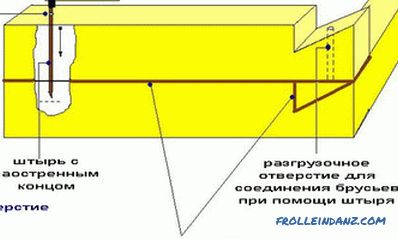Stone sinks came into fashion relatively recently - a few decades ago. They are comfortable, beautiful, relatively inexpensive and easy to install and use. But, at the same time, they have a number of shortcomings that relate to both objective and subjective characteristics. How practical is the stone sink for the kitchen, the pros and cons of which we will discuss below - the reader himself will decide. In the article we present only the facts.
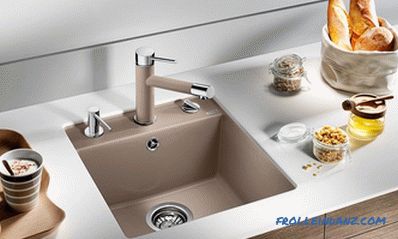
Of what materials can be made stone sinks
The term "stone" means a lot of natural and composite materials whose properties to some extent resemble natural a rock. Externally, sinks from different materials can be very different or be almost identical - it all depends on the designer's intention and the manufacturer's capabilities.
The most common materials for the production of sinks are:
- porcelain stoneware;
- acrylic stone;
- agglomerate.
There are sinks made from natural marble, granite and other types of waterproof natural stone. But they are expensive and distributed relatively little. First consider the most popular designs.
Pros and cons of ceramic-granite sinks for the kitchen
In essence, this is an artificial material made from natural ingredients. It contains special types of clay, which is used for the production of ceramic tiles, quartz sand of small fractions, metal oxides. After mixing in a certain proportion, the obtained semi-liquid mass is pressed, thus forming the desired product, fired at high temperatures - 1200 - 1400 0 C.
The result is a sturdy product that does not differ in properties from granite. The beauty of porcelain stoneware is that it can be given almost any shape. This opens up broad prospects for designers - from one material you can make tabletops, window sills, sills, embed it in the lining in the form of décor or aprons.
Porcelain has a lot of useful properties. However, not everything is so perfect. There is also an obligatory "fly in the ointment" in the complete washing of honey. But most of the troubles with porcelain sinks can be avoided if properly exploited.
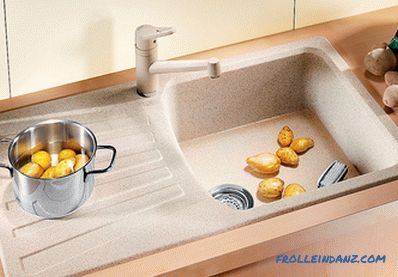
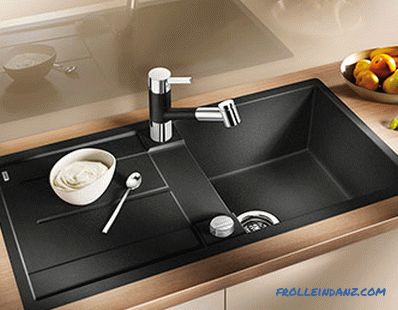


+ Advantages of kitchen sinks made of porcelain stoneware
- Durability - service life up to 100 years.
- Practicality - the surface is difficult to scratch or crack, it is perfectly cleaned and neutral to most household products, does not absorb fat and coloring matter.
- Wear resistance - even when cleaning with brushes and abrasive powders, it is difficult to damage the surface.
- Resistance to mechanical stress - in order to break the sink, you must use at least a hammer, random blows are not afraid of it.
- Heat resistance - the sink does not crack or deform from boiling water, no volatile substances and odors are emitted.

- Cons of kitchen sinks made of ceramic
- Price - compared to other types of sinks, stoneware significantly more expensive, but when you consider the service life of 100 years, the price does not seem so frightening.
- The possibility of mechanical damage under severe shock loads - surface chips and non-through cracks may occur, for example, when metal utensils fall from the height of the upper shelf of the cabinet. But damage is easily repaired with a special mass and almost imperceptible.
It can be said unequivocally - if you have a spacious kitchen, furnished with designer furniture and decorated in the same style, then you can always find a ceramic-granite sink that fits in with the decor. This will be one of the best solutions.
Pros and cons of composite sinks for the kitchen of acrylic stone
Composite sinks of acrylic stone are made of artificial material consisting of natural and synthetic components. Natural - granite or marble chips, quartz sand, basalt. Synthetic - acrylic resin, acting as a binder. It is produced in the form of flat panels of a given thickness, from which a product of a given configuration is formed. If joints are formed between the walls and the bottom, they are sealed with the same acrylic-mineral mixture and ground.
The joints are not inferior in strength to the base material and do not appear with time. To fear leaks at the seams should not be, even after deformation effects. But with all the attractiveness of composite sinks, they clearly have more minuses than porcelain stoneware.
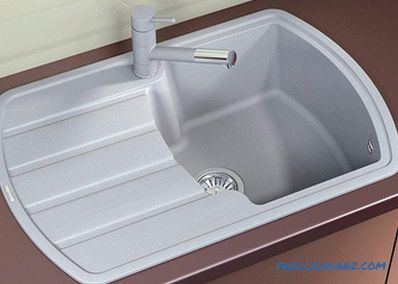
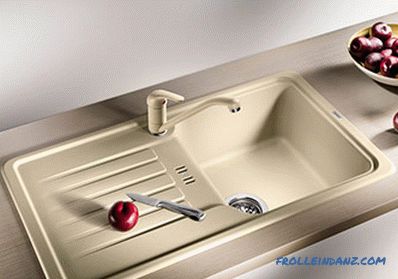
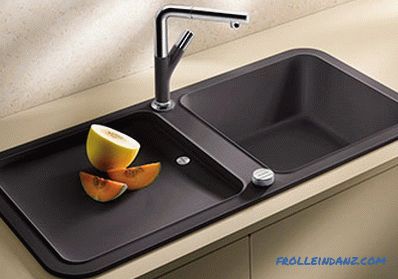

+ Advantages of composite sinks for the kitchen of acrylic stone
- A variety of shapes, components can be mounted in any straight or curved configuration;
- Zero toxicity, at any temperature acrylic and mineral fillers do not emit toxic volatile and liquid substances. The material is chemically neutral to alkalis, acids and components of detergents;
- High maintainability, any cracks, scratches and chips are easily sealed with special acrylic pastes that are inexpensive and highly technological in application;
- Low weight, the material is an order of magnitude lighter than porcelain stoneware or natural stone, which allows you to install them on fairly lightweight frames.

- Disadvantages of composite sinks for the kitchen of acrylic stone
- Low resistance to mechanical stress. It is enough to damage the surface simply by hitting it with a metal object, for example, carelessly losing a frying pan. When damage occurs scratches or chips;
- Low heat resistance, boiling water should not be poured into the sink;
- Some types of acrylics well absorb dyes, beetroot or berry juice, for example, you should immediately wash it off if it absorbed, it will be difficult to wash the sink. But when buying, pay attention to the presence of surface treatment, if it exists, then this minus does not appear;
- Cost. With so many drawbacks, the price of washing is too high.
Buy an acrylic sink is not the worst option. With careful handling, it will last at least 50 years. If you have designer furniture in a modern style, then it will not be difficult to choose any unusual sink made of acrylic.
Pros and cons of kitchen sinks made of sinter
A material consisting of a large amount of mineral crumb, much larger than that of acrylic, and a certain amount of polymers connecting them into one monolithic mass. The main material is marble, basalt, quartz, granite, or mixtures thereof. Binders - polymeric resins, after solidification forming durable, water-resistant, chemically inert compounds. Color products give resistant to water, UV and chemical reagents pigments. When touched, agglomerate sinks are indistinguishable from natural stone bowls - the same smoothness and pleasant coolness.
The agglomerate stone sink for the kitchen has the same advantages and disadvantages as porcelain stoneware in the number of products with great potential. Constantly emerging new types of binders provide an opportunity to continuously improve product performance.


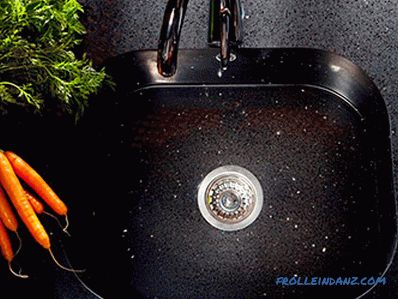

+ Pros of sinks for the kitchen of sinter
- High strength and durability, not lower than porcelain stoneware;
- No need for polishing, damaging or mating the surface will not work even when using abrasives;
- Zero adhesion to fats;
- Lack of absorption of dyes, juice drops, wine, coffee do not linger on the walls and bottom and are easily washed off water;
- A variety of shapes and colors, you can always choose what best suits the interior and ergonomics.

- Disadvantages of kitchen sinks from sinter
- The complexity of restoring the integrity of the wash after damage. But you can only damage it with great desire and diligence;
- Fewer design solutions than acrylic, but the remaining parameters are much better;
- A rather high cost, more expensive than acrylic, is cheaper than ceramic or natural stone .
When choosing a kitchen sink, you must first focus on the functionality. According to the material, porcelain tile is best suited to the classical style, acrylic - to eclecticism, modern and loft, and sinter - for functional techno and modern. But the choice is yours. Judging broadly, all types of stone sinks have the right to life and allow you to choose a product to your own taste.
